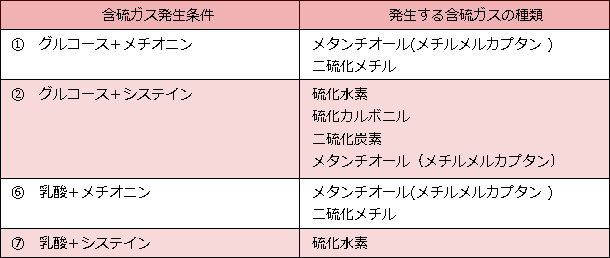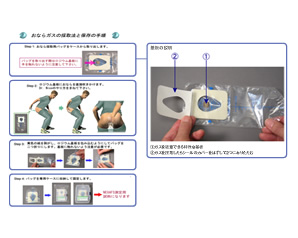We observed that a unique odor emanates from open tumor lesions from oral cancer patients. This type of odor signifies that the tumor tissue is synthesizing some type of volatile substance. We were interested in whether this odor was "simply coming from dead tissue as a result of extensive tissue proliferation and necrosis" or "as a result of some chemical reactions related to cancer proliferation and metastasis". In the case of the latter, the generation of this odor is not only relevant to oral cancers but to all other types of cancers as well, and would greatly assist in understanding of the nature of cancer.
You may be aware of recent newspaper articles that described dogs that were able to detect the presence of cancer from by smell(2-4). The fact that dogs can detect cancer-specific smells indicates the occurrence of the release of unique volatile substances from the body and clearly demonstrates that the odor from oral cancer patients is related to this phenomenon. We recognized that identifying the odor-causing substances from tumor tissues would bring us closer to understanding the nature of cancer. Due to variability in the canine sense of smell, however, it is quite difficult to scientifically quantitate odor composition. If dogs are able to accurately evaluate odor composition from exhaled breath and flatus, we would be able to detect the presence of cancer in the colon or the lungs without the use of invasive and painful procedures, or even X-ray examinations.
(1) Gas generated by lung cancer tissue
Exhaled breath collection method and composition analysis from lung cancer patients:(Figure 2)
Special substrate-coated plates that can adhere gas particles from exhaled breath were produced and subjects were asked to exhale on the plates, which were then used to analyze the gas composition. Results have shown much higher levels of the sulfur-containing gases, hydrogen sulfide (peak at 2471eV) and methanethiol (peak at 2472.5eV) from the breath of lung cancer patients (Figure 3) than from healthy subjects. Subjects were asked to exhale from the nose rather than from the mouth in order to exclude odor-containing gases from non-cancerous sources such as from cavities and periodontal disease.
(2) Gas generated by colon cancer tissue
Flatus collection method and composition analysis from colon cancer patients:(Figure 4)
As shown in Figure 4, the composition of gases was analyzed using near-edge X-ray fine adsorption structure spectroscopy (NEXAFS) by applying flatus directly to special substrate-coated plates as described in the lung cancer example.
The methanethiol level (methyl mercaptan) in the flatus from colon cancer patients was significantly higher compared to healthy subjects, and a trend was observed where higher levels correlated with disease progression (early to late stage). In contrast, the level of methanethiol was relatively low in healthy subjects and remained consistently low (within a safe level).
In order to assess the level of gas generation from consumed food, eggs from Silkie chickens, which are rich in sulphur, were given to a group of individuals (10 per day for 3 days) and their flatus was collected on the fourth day. Results showed that the methanethiol level remained low and was well within the normal range (Figure 5).
These results demonstrate that the flatus reflects the composition of gas inside the colon and indicate the effectiveness of colon cancer screening by measuring the level of sulfur-containing gases.
(3) Conditions for sulfur-containing gases generated by tumors
Simulation of gas generation in vitro
The reducing sugar, glucose, and the sulfur-containing amino acid, methionine, are well known substances that accumulate in tumor tissues. These substances are used as tumor tissue markers in Positron emission tomography (PET).
Sugars and amino acids in tumor tissues induce the Maillard reaction. We found that this reaction does not require special catalyst enzymes, but rather occurs as a pure chemical reaction which generates various sulfur-containing gases such as hydrogen sulfide and methanethiol. In other words, tumor tissues generate many volatile sulfur-containing gases through various chemical reactions, including the Maillard reaction.
(4) Gas generated in tumor tissues in vivo (in mice)
Confirmation of the generation of sulfur-containing gases from tumor tissues in vivo(1):
Nude mice were transplanted with human colon cancer cells (HT26) and tumors were removed after reaching a certain size. The gas generated from the excised tumor tissues was immediately adhered to the special substrate plate and analysed by spectroscopy (XAFS). Results showed generation of hydrogen sulphide and methanethiol (methyl mercaptan) from tumor tissues in vivo(1).
To investigate the relationship between sulfur-containing gas diffusion and cancer metastasis, a solution that induces gas generation (Figure 6) was injected into the flank of mice and changes in the tumor suppressor gene, p53, were noted. Results showed an increase in p53 in the flank where injection occurred and a similar increase was also observed in the non injected side (opposite side of the injection site). These results demonstrate that sulfur-containing gases generated by tumors diffuse throughout the body via the blood circulation and lymphatic systems and consequently induce tumor proliferation and metastasis (1).
Figure 6





